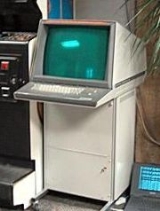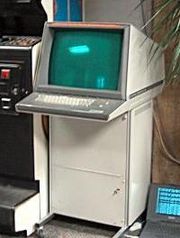
Storage tube
Encyclopedia

Electron gun
An electron gun is an electrical component that produces an electron beam that has a precise kinetic energy and is most often used in television sets and computer displays which use cathode ray tube technology, as well as in other instruments, such as electron microscopes and particle...
, it stays lit until a screen erase command is given. Thus, screen update commands need only be sent once and this allows the use of a slower data connection, typically serial
Serial communications
In telecommunication and computer science, serial communication is the process of sending data one bit at a time, sequentially, over a communication channel or computer bus. This is in contrast to parallel communication, where several bits are sent as a whole, on a link with several parallel channels...
—a feature very well adapted to computer terminal
Computer terminal
A computer terminal is an electronic or electromechanical hardware device that is used for entering data into, and displaying data from, a computer or a computing system...
use in 1960s
1960s
The 1960s was the decade that started on January 1, 1960, and ended on December 31, 1969. It was the seventh decade of the 20th century.The 1960s term also refers to an era more often called The Sixties, denoting the complex of inter-related cultural and political trends across the globe...
and 1970s
1970s
File:1970s decade montage.png|From left, clockwise: US President Richard Nixon doing the V for Victory sign after his resignation from office after the Watergate scandal in 1974; Refugees aboard a US naval boat after the Fall of Saigon, leading to the end of the Vietnam War in 1975; The 1973 oil...
computing. The two main advantages were:
- Very low bandwidth needs compared to vector graphicsVector graphicsVector graphics is the use of geometrical primitives such as points, lines, curves, and shapes or polygon, which are all based on mathematical expressions, to represent images in computer graphics...
displays, thus allowing much longer cable distances between computer and terminal - No need for display-local RAMRandom-access memoryRandom access memory is a form of computer data storage. Today, it takes the form of integrated circuits that allow stored data to be accessed in any order with a worst case performance of constant time. Strictly speaking, modern types of DRAM are therefore not random access, as data is read in...
(as in modern terminals), which was prohibitively expensive at the time.
Generally speaking, storage tubes could be divided into two categories. In the more common category, they were only capable of storing "binary
Binary numeral system
The binary numeral system, or base-2 number system, represents numeric values using two symbols, 0 and 1. More specifically, the usual base-2 system is a positional notation with a radix of 2...
" images; any given point on the screen was either illuminated or dark. The Tektronix
Tektronix
Tektronix, Inc. is an American company best known for its test and measurement equipment such as oscilloscopes, logic analyzers, and video and mobile test protocol equipment. In November 2007, Tektronix became a subsidiary of Danaher Corporation....
Direct-View Bistable Storage Tube
DVBST
Direct-View Bistable Storage Tubes was an acronym used by Tektronix to describe their line of storage tubes. These were cathode ray tubes that stored information written to them using an analog technique inherent in the CRT and based upon the secondary emission of electrons from the phosphor...
was perhaps the most famous example in this category. Other storage tubes were able to store greyscale/halftone
Halftone
Halftone is the reprographic technique that simulates continuous tone imagery through the use of dots, varying either in size, in shape or in spacing...
d images; the tradeoff was usually a much-reduced storage time.
Some pioneering storage tube displays were MIT Project MAC's ARDS (Advanced Remote Display Station), the Computek 400 Series Display terminals (a commercial derivative), which both used a Tektronix type 611 storage display unit, and Tektronix's 4014
Tektronix 4014
The Tektronix 4000 series was a family of text and graphics computer terminals based on the company's storage tube technology. No additional electronics were needed to maintain the display, so the 4000 series were less expensive than earlier graphics terminals and became widely used in the CAD...
terminal, the latter becoming a de facto
De facto
De facto is a Latin expression that means "concerning fact." In law, it often means "in practice but not necessarily ordained by law" or "in practice or actuality, but not officially established." It is commonly used in contrast to de jure when referring to matters of law, governance, or...
computer terminal standard some time after its introduction (later being emulated by other systems due to this status).
The first generalized computer assisted instruction system, PLATO I, ca. 1960 on ILLIAC I
ILLIAC
ILLIAC was a series of supercomputers built at a variety of locations, some at the University of Illinois at Urbana-Champaign. In all, five computers were built in this series between 1951 and 1974...
, used a storage tube as its computer graphics display. PLATO II and PLATO III also used storage tubes as displays.
See also
- Direct-View Bistable Storage Tube (DVBST)
- OscilloscopeOscilloscopeAn oscilloscope is a type of electronic test instrument that allows observation of constantly varying signal voltages, usually as a two-dimensional graph of one or more electrical potential differences using the vertical or 'Y' axis, plotted as a function of time,...
(for an explanation of how analog storage worked) - Williams tubeWilliams tubeThe Williams tube or the Williams-Kilburn tube , developed in about 1946 or 1947, was a cathode ray tube used to electronically store binary data....
and Selectron tubeSelectron tubeThe Selectron was an early form of digital computer memory developed by Jan A. Rajchman and his group at the Radio Corporation of America under the direction of Vladimir Zworykin, of television technology fame...
both used the term "storage tube" for early computer memory devices - Electronic paperElectronic paperElectronic paper, e-paper and electronic ink are a range of display technology which are designed to mimic the appearance of ordinary ink on paper. Unlike conventional backlit flat panel displays, electronic paper displays reflect light like ordinary paper...

